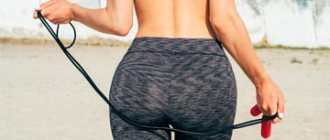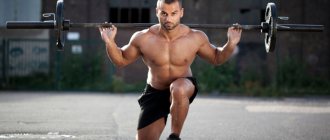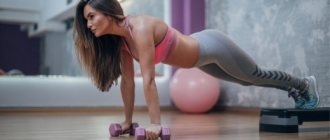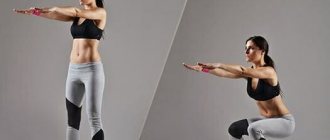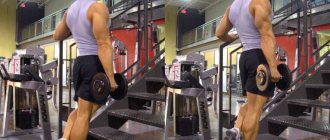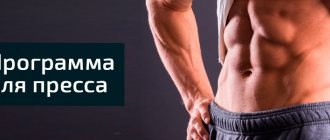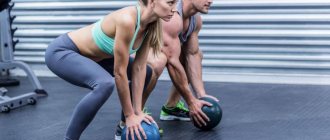It’s no secret that the beautiful shape of a woman’s butt affects both guys and older men no worse than the red banner of a bullfighter affects a bull. And absolutely regardless of whether these nut-shaped and toned buttocks are covered in denim shorts from a sale or a dress from Armani. This is how nature decreed it - whether someone likes it or not. Obviously, working on this part of the body is very important for girls and women. But not all of them are ready to immediately sign up for a gym and gruelingly work with a barbell.
Is it possible to get by with cheaper and simpler means? It turns out that it is possible! And the main one of these means is called “squats”. But how much do you need to squat to pump up your buttocks? How often and with what load should I do this? Use one or more variations of this exercise? And is it necessary to combine this with proper nutrition? Let's start answering the questions posed in order.
Why are squats without weight so popular?
When considering the question of whether it is possible to pump up your legs with squats without weight, it should be said first of all about the reasons for the popularity of this exercise among amateur athletes:
- the trainee does not like to exercise with additional weights and is confident that by working with his own body, he will be able to achieve his goals;
- the trainee does not have the time, money and desire to visit the gym;
- There is not enough space in the house to do any other more advanced exercises.
We work at home
The technique of squats at home is no different from the technique in the gym. All the same points that I listed above apply here. The only difference is that at home you have a much smaller selection of equipment .
If in the gym there are different exercise machines, barbells, dumbbells, weights, then at home you only have enthusiasm and a wild desire to make your buttocks the national treasure of your country, and sometimes 2 kilogram dumbbells.
Yes, perhaps you are a serious woman and you have a personal mini-gym at home, then it will be much easier for you to acquire a beautiful butt. But that's a completely different story.
In general, if you decide to pump up your butt at home with squats, then you must understand that you will not see such a quick and noticeable result as in the gym. If only because muscle growth requires stress, in most cases this stress is caused by an increase in load, usually this is done by increasing the working weight. It is difficult to increase the load at home .
Of course, you can first squat with your own weight, then pick up dumbbells, then a microwave, then throw the refrigerator on your shoulders, but this will be extremely inconvenient.
Therefore, I advise you to achieve certain results at home, and then move to the gym.
Leg workout
The human legs are made up of muscles that increase in size if exercised properly. It is necessary to understand that the volume of this part of the body can only be increased through regular and proper training over a long period of time. When people ask how to build toned legs, the answer is that squats are the main exercise to achieve this goal.
The human legs are made up of three main muscles: the back and front of the thighs, the adductors (the inner part) and the calves. The quadriceps (outer surface) is the largest and most prominent muscle; others help keep a person upright and move the joints. The answer to the question of whether you can get bigger legs by doing squats without weights is yes, but understand that genetics play some role and many people have naturally large legs.
How deep should you squat?
Stopping flexion is, as you remember, one of the controversial issues. Let's say goodbye to the myth about the dangers of full squats. A healthy person who has no contraindications in the hips, knees or spine is able to withstand this exercise without harming himself. You can squat a quarter, a half, or a full depth with ease, as Powers and Salem proved in 2002. The research results are published in J Orthop Sports Phys Ther (32nd issue) on pages 141-148.
The Role of Additional Weight During Squats
When considering how to pump up your legs with squats, the first thing to note is the role that additional weight plays. Both squats with and without additional weight help develop muscles. Squats without weight increase muscle strength in the legs, while squats with additional weight, in addition to increasing strength, also increase volume. Many athletes, as a rule, use weights up to 70-80% of their own body weight in their training during squats.
Benefits of Exercise
Something as simple as barbell squats has a lot of benefits for men. This movement is difficult to replace with anything or find a more effective one.
- Benefits for athletes. Power squats with a barbell on the shoulders help build the athlete's muscle mass and increase muscle strength. Squats with serious weight affect the active functioning of the nervous system, and this causes the production of muscle growth hormones.
- Pros for men. Due to the fact that this movement promotes the active production of testosterone and increased blood supply in the pelvis, the health of the male reproductive system improves.
- Pros for women. Due to the work of different muscle groups, women from squats with a barbell develop toned legs: thighs and buttocks, and excess subcutaneous fat is burned faster thanks to the additional load in the form of a barbell.
- Pros for beginners. By strengthening ligaments, tendons and muscles, which are stabilizers, joint mobility, movement coordination, and posture improve. The chest expands and a muscle corset is formed. And if you follow the correct technique, the load will be evenly distributed across the joints, strengthening them and reducing the likelihood of injury later. When done correctly, the exercise will develop the neuromuscular connection between the hip, knee and ankle joints so that they work in harmony.
About the different types of squats
No one doubts the benefits of squats without weight for men and women. The exercise is necessary to give a beautiful shape to a person’s buttocks and legs, and the type of squats determines which parts of the legs are loaded more and which are used less.
First of all, the starting position largely determines the load on the muscles. The wider your legs are from each other during squats, the more load the inner thighs receive, and the less load falls on the buttocks. The depth of the squat also plays a fundamental role; the lower the athlete sits, the more the buttocks are involved in the work.
Squats are a compound exercise. This means that in the process of performing them, various muscle groups are involved in the work, and not just the muscles of the buttocks and thighs; in fact, the entire lower part of the person’s body receives physical activity.
Contraindications
Squats are even used in children's exercise routines and in physical education classes. Despite its versatility and high efficiency, there are a number of contraindications for which training is not recommended:
- there are problems with the joints of the lower extremities;
- varicose veins;
- large body weight, which creates too much stress on the knees and ankles;
- diseases, hernias, injuries and damage to the spine;
- hypertension, pressure changes.
You should also consult a doctor if you have cardiovascular diseases or chronic diseases. If discomfort or severe pain or shortness of breath appears during the exercise, it is better to exclude squats from the physical complex.
Starting position for traditional squats
The correct technique for an unweighted squat is to place your feet slightly wider than hip-width apart. In this case, the toes should be slightly turned outward, the arms should be extended forward in front of you, which allows you to improve the stabilization of the body during the exercise.
Subsequently, during squats, you should move your chest a little forward, bringing your shoulder blades closer together, and also engage your abdominal muscles. All this allows you to improve the dynamics of movements.
How to breathe
During classic squats, breathing movements look like this:
- while squatting, inhale slowly through your nose until your hips bend to 90°;
- during the ascent, exhale vigorously through the mouth or nose.
To give freedom to expand the chest, you need to extend your arms or cross them over your chest (you can also hold them behind your head). It is unacceptable to lower the limbs along the body, since this allows a person to inhale less oxygen. When squats, it is better to use abdominal breathing, which allows you to draw more air into your lungs. [1]
Mechanics of movement during squats
You should start the exercise slowly, bending your knees and lowering yourself as if you were sitting on a chair. The head and shoulders should be in a straight line along with the knees and ankles. In this case, the body weight should be distributed evenly over the surface of the entire foot. You should lower yourself until your hips are slightly below your knees. As you lower, it is recommended to raise your arms up to improve balance and stabilize the movements being performed. When an athlete performs squats without weight, his back and chest should remain straight at all times and should not be pushed forward.
As soon as the body is lowered, you should also slowly rise and return to the starting position.
What do experts recommend remembering first?
- You should start squats after a short warm-up. In our case, it includes a slight rotation of first the ankle, then the foot of one leg, and then the other. It is necessary to make at least 8–10 rotational movements.
- In most squat methods, you need to rest on your entire foot, without lifting up on your toes.
- The back should always remain straight.
- While doing squats, keep your abdominal muscles tense. Thus, in parallel with training the gluteal muscles, you will achieve a small loss of fat from the abdomen, and also strengthen the muscle corset in the back and lower back.
- Don't try to do too many squats per unit of time. Medium pace is not only safer, but also more effective.
- Breathe evenly, lowering with a slow inhale and rising with a full exhale.
Non-traditional types of squats without weight
The positive effect of squats without weight on the leg muscles can be increased if you practice not only traditional squats, but also their other types. The following are the most common non-traditional types of exercise:
- With support on the wall: in this type of squats, you need to take the starting position exactly the same as in the case of regular squats, only this time your hips will rest against the wall. After lowering your hips to knee level, you need to stay in this position for 10 seconds and then return to the starting position.
- Narrow squats: Place your feet together and extend your arms forward to maintain balance. Lower your body until your thighs are parallel to the floor, then lift your body and return to the starting position.
- Back Squats: The starting position for this exercise is exactly the same as for the narrow squats. At the final stage of the exercise, when the legs are almost straightened, it is necessary to throw the right leg back, while straining the buttocks. During the next squat, do the same with your left leg.
- Sumo squats: They are performed with the legs wide apart, the toes of the feet pointing outward, and the hands placed together on the chest. When performing squats, your back should be straight.
We pump up our legs with lunges and extensions in the simulator
Extensions are a useful exercise for the legs, both as a warm-up and for work during the main workout. Since this is a growth exercise, you must be extremely careful. It seems simple, but many athletes get burned by it. Straighten your entire leg from your quads to your calves. How you do this is another important question. Extension is carried out by tensioning the quadriceps, but also try to simultaneously pull your feet up. Make sure your back is firmly pressed into the seat and your hips are not lifting off.
Don't ignore lunges if you want to quickly build up your leg muscles. You will be surprised, but many people do this exercise incorrectly. When performed correctly, a clear line is drawn not only in the quadriceps, but also in the hamstrings, and the shape of the buttocks also improves, which is especially important for girls.
Sports nutrition will help speed up the process of gaining muscle mass - protein, creatine, gainer, arginine, BCAA, amino acids. These supplements are specially designed for athletes and fitness-active people of different fitness levels. Such drugs are completely safe, and their effectiveness has already been proven.
No related posts
Benefits of Squats Without Weight
The answer to the question of whether it is possible to pump up your legs with squats without weight has already been given above. Now let's look in more detail at the question of what benefits there are from performing this exercise. Many fitness trainers recommend including squats in your workouts. Is there any benefit to doing squats without weight? The answers are in the list below:
- Squats allow you to train the endurance of the leg muscles, and can also serve as a warm-up for the muscles before performing exercises that require greater muscle effort and energy consumption. These exercises involve a large number of muscle groups, which allows you to quickly increase your body temperature, preparing it for the training process.
- Squats are effective for burning excess calories. It is also important that this exercise is quite simple, so it can be performed as part of more complex complexes. In addition, they can be performed by people with different levels of physical fitness.
- You can do squats without weight every day because they only require a small amount of space and there is no need for any additional equipment.
- Exercise helps train the cardiovascular system and accelerates metabolism in the body.
- The benefits of squats without weight are undeniable, but when an athlete has already mastered the technique of performing them to a perfect degree, additional weights should be added. It is recommended to start working with weights under the guidance of a trainer, since additional load if used incorrectly can lead to serious injuries.
Squat programs for a month
To make it easier to monitor your progress and achieve visible results, you should practice special squat patterns.
They are suitable for both home and gym.
Standard for buttocks
The standard squat program for girls for 30 days is presented in the table. To pump up your buttocks while exercising, you need to squat with a wide stance below parallel.
| Days | Number of repetitions | Approaches | |
| Week 1 | Monday | 10 | 3 |
| Thursday | 12 | 3 | |
| Week 2 | Monday | 12 | 4 |
| Thursday | 15 | 3 | |
| Week 3 | Monday | 15 | 4 |
| Thursday | 18 | 3 | |
| Week 4 | Monday | 20 | 3 |
| Thursday | 20 | 4 | |
If desired, you can use a small weight. At home, its role can be played by bottles of water or a backpack with books.
For weight loss
If the goal of the exercise is to lose weight, you can do squats according to this plan.
| Days | Number of repetitions | Approaches |
| 1 | 15 | 3 |
| 2 | Rest | Rest |
| 3 | Rest | Rest |
| 4 | 15 | 4 |
| 5 | Rest | Rest |
| 6 | Rest | Rest |
| 7 | 20 | 3 |
| 8 | Rest | Rest |
| 9 | Rest | Rest |
| 10 | 20 | 4 |
| 11 | Rest | Rest |
| 12 | Rest | Rest |
| 13 | 20 | 5 |
| 14 | Rest | Rest |
| 15 | Rest | Rest |
| 16 | 25 | 3 |
| 17 | Rest | Rest |
| 18 | 25 | 4 |
| 19 | Rest | Rest |
| 20 | 25 | 5 |
| 21 | Rest | Rest |
| 22 | 25 | 6 |
| 23 | Rest | Rest |
| 24 | 30 | 3 |
| 25 | Rest | Rest |
| 26 | 30 | 4 |
| 27 | Rest | Rest |
| 28 | 30 | 5 |
| 29 | Rest | Rest |
| 30 | 30 | 6 |
You need to increase the number of repetitions whenever possible. If the muscles of your legs or buttocks still hurt, the next workout on your schedule should be postponed for at least a day.
Workout “200 squats”
There is another interesting system that allows you to learn how to squat 200 times in one workout. The course lasts 6 weeks.
The peculiarity of this program is that before starting classes you will need to take a test. It consists of checking the maximum number of times a particular person can sit down.
When taking this test, it is important to follow the correct technique and objectively assess your capabilities, that is, not to inflate the final figure.
As a result, you need to determine your level of training using this table.
| Number of squats | Level |
| to 10 | Elementary |
| 10-20 | Average |
| More than 20 | Advanced |
Now you can move directly to the squat programs. Classes should be conducted 3 times a week in each scheme.
Elementary
For 6 weeks, beginners will need to perform squats according to the programs presented in the tables. "No" indicates the approach number.
Week 1:
| Day | Number of repetitions | Total squats per day | ||||
| №1 | №2 | №3 | №4 | №5 | ||
| Monday | 3 | 4 | 3 | 3 | 5 | 18 |
| Wednesday | 5 | 5 | 3 | 5 | 5 | 23 |
| Friday | 5 | 6 | 5 | 5 | 7 | 28 |
Week 2:
| Day | Number of repetitions | Total squats per day | ||||
| №1 | №2 | №3 | №4 | №5 | ||
| Monday | 6 | 8 | 5 | 5 | 8 | 32 |
| Wednesday | 6 | 8 | 5 | 5 | 10 | 34 |
| Friday | 7 | 11 | 7 | 7 | 11 | 43 |
Week 3:
| Day | Number of repetitions | Total squats per day | ||||
| №1 | №2 | №3 | №4 | №5 | ||
| Monday | 13 | 16 | 10 | 10 | 13 | 62 |
| Wednesday | 13 | 16 | 11 | 11 | 16 | 67 |
| Thursday | 15 | 18 | 13 | 13 | 18 | 77 |
Week 4:
| Day | Number of repetitions | Total squats per day | ||||
| №1 | №2 | №3 | №4 | №5 | ||
| Monday | 16 | 19 | 15 | 13 | 22 | 85 |
| Wednesday | 19 | 22 | 16 | 16 | 24 | 97 |
| Friday | 22 | 24 | 18 | 18 | 27 | 109 |
Week 5:
| Day | Number of repetitions | Total squats per day | |||||||
| №1 | №2 | №3 | №4 | №5 | №6 | №7 | №8 | ||
| Monday | 23 | 27 | 21 | 21 | 27 | — | — | — | 119 |
| Wednesday | 13 | 13 | 18 | 18 | 13 | 13 | 13 | 34 | 135 |
| Friday | 16 | 16 | 20 | 20 | 16 | 16 | 13 | 40 | 157 |
Week 6:
| Day | Number of repetitions | Total squats per day | |||||||
| №1 | №2 | №3 | №4 | №5 | №6 | №7 | №8 | ||
| Monday | 34 | 40 | 27 | 20 | 54 | — | — | — | 175 |
| Wednesday | 19 | 19 | 21 | 21 | 19 | 19 | 13 | 59 | 190 |
| Friday | 18 | 18 | 23 | 23 | 22 | 22 | 19 | 67 | 212 |
As a result of training in this program, you can significantly strengthen your muscles, making your legs and buttocks toned and elastic.
Average
The squat program for an intermediate level will differ in that from the first days you will have to do more squats. But after 6 weeks you will be able to do more than 300 squats in one workout.
Week 1:
| Day | Number of repetitions | Total squats per day | ||||
| №1 | №2 | №3 | №4 | №5 | ||
| Monday | 8 | 8 | 5 | 5 | 7 | 33 |
| Wednesday | 8 | 11 | 8 | 8 | 9 | 44 |
| Friday | 11 | 13 | 10 | 10 | 13 | 57 |
Week 2:
| Day | Number of repetitions | Total squats per day | ||||
| №1 | №2 | №3 | №4 | №5 | ||
| Monday | 13 | 15 | 11 | 11 | 15 | 65 |
| Wednesday | 13 | 15 | 13 | 13 | 18 | 72 |
| Friday | 16 | 18 | 13 | 13 | 21 | 81 |
Week 3:
| Day | Number of repetitions | Total squats per day | ||||
| №1 | №2 | №3 | №4 | №5 | ||
| Monday | 16 | 22 | 17 | 17 | 22 | 94 |
| Wednesday | 19 | 25 | 19 | 19 | 25 | 107 |
| Friday | 22 | 29 | 20 | 21 | 29 | 121 |
Week 4:
| Day | Number of repetitions | Total squats per day | ||||
| №1 | №2 | №3 | №4 | №5 | ||
| Monday | 24 | 30 | 22 | 22 | 34 | 132 |
| Wednesday | 27 | 34 | 27 | 27 | 38 | 153 |
| Friday | 31 | 38 | 31 | 21 | 45 | 166 |
Week 5:
| Day | Number of repetitions | Total squats per day | |||||||
| №1 | №2 | №3 | №4 | №5 | №6 | №7 | №8 | ||
| Monday | 38 | 47 | 34 | 30 | 47 | — | — | — | 196 |
| Wednesday | 24 | 24 | 27 | 27 | 19 | 19 | 22 | 54 | 216 |
| Friday | 23 | 23 | 27 | 27 | 23 | 23 | 27 | 60 | 233 |
Week 6:
| Day | Number of repetitions | Total squats per day | |||||||
| №1 | №2 | №3 | №4 | №5 | №6 | №7 | №8 | ||
| Monday | 54 | 67 | 34 | 31 | 67 | — | — | — | 253 |
| Wednesday | 27 | 27 | 31 | 31 | 27 | 27 | 24 | 72 | 266 |
| Friday | 30 | 30 | 40 | 40 | 31 | 31 | 24 | 80 | 306 |
The result of such a program is already more serious. But it is possible to achieve it if you practice disciplined and regularly.
How many squats per day is recommended?
It is not easy to answer this question, since the specific number of squats depends on a number of factors: the physical condition of the student, age, his weight and the goal that he has set for himself.
If we talk about beginner athletes, then they should start with high-repetition squats without weight. However, first you need to master the correct technique for performing them. In the first week of training, it is recommended to perform 4-5 series of 10 squats. Thus, a novice athlete will perform 40-50 squats a day, and training should be done every other day so that the leg muscles have time to rest and recover.
Subsequently, you can either increase the number of squats or start using additional weights. You will soon notice that the muscles in your legs have become stronger, and your legs themselves look more beautiful and toned.
How long will it take?
Let’s say right away that the transformation of an office worker’s butt into J.Lo’s butt (if not in size, then in elasticity) cannot be achieved in a week. And in a month too. Since clearly visible results will appear only after 3-4 months. And significant ones - in a year. But if you have set yourself the goal of always having gorgeous buttocks (and not forming them for the beach season, which begins in two weeks), you will have to work!
In addition, daily exercise will need to be combined with proper nutrition. Which means at least three rules:
- No fast food, baked goods, chips or cakes.
- Fruits, vegetables, herbs, dairy products, lean meat and fish assorted.
- Balance of proteins, carbohydrates and fats recommended by nutritionists.
The same set of rules applies to squats.
- You can start doing squats once every two days, gradually moving to daily exercises.
- There is no need to torture yourself - a total time of 30 minutes a day will be enough.
- The pace can be kept average - but as the muscles strengthen, the same number of squats should be performed with weights (in order not to dry out the body, but only to make the buttocks attractive, it is not recommended to switch to weights exceeding 70% of your body weight).
Mistakes when performing squats
Despite the fact that squats without weight are a fairly simple exercise that even a beginner can do, there are still errors in execution that can lead to damage to certain parts of the athlete’s body. Let's look at them:
- First of all, squats should be done slowly and not go too low, since you can damage the ligaments in the knee joints. Shallow squats, in turn, strengthen the knees and increase the strength of the quadriceps and thigh muscles.
- It is not recommended to perform the exercise too quickly. The fact is that when lowering quickly, the body acquires great acceleration, and then it is difficult to lift it, due to its inertial properties. Fast squats significantly increase the load on the knee joints, which significantly increases the risk of injury. In addition, performing the exercise quickly causes imbalance and makes it difficult for the athlete to maintain proper technique.
- Not only the knees, but also the lumbar area experiences stress when performing squats. A common mistake athletes make is bending the body in the abdominal area during an exercise. This occurs when the hips rise faster than the shoulders and the upper body leans forward. This incorrect technique can lead to injuries in the lumbar region, such as a slipped disc.
- Raising your heels during squats is a mistake. This happens due to limited mobility in the hips and ankles. If a beginner makes this mistake, it is recommended to place a thin plate under the heels to make them higher. This measure helps to master the correct technique, but should not be abused. It is also recommended to develop the joints in the ankles and hips, increasing the range of motion.
Want to pump up your legs quickly? Train to failure
Many people perform shoulder or chest sets to the point of exhaustion every workout, but cannot handle the same load on their legs. Why is this happening? Forced repetitions are what will help you build up your legs quickly. And yes, this applies to squats too.
Before you pick up a barbell and start squatting, you need to warm up well.
We recommend an exercise bike, elliptical or treadmill for at least 5-8 minutes. Work at a moderate pace, enough to work up a sweat. Immediately after this, spend 10 minutes stretching. Remember: you need to stretch not only your quadriceps, but also all the muscles in your legs and lower back. To complete your warm-up, do 2-3 sets of 20, 18, 15 repetitions of leg extensions on the machine. You shouldn’t push yourself; on the last set of the warm-up you should be fully prepared for hard work. Check: your back is pressed tightly against the backrest, your hips are pressed against the seat. And most importantly, additionally tighten your quadriceps. If you think that this is too much for warming up, don’t worry, it’s necessary. Now you are ready to begin leg pumping exercises.
Squat to pump up your legs quickly
Most people find squats difficult. This exercise only seems easy from the outside: just bend your legs, squat down, and then straighten up. But it's not that simple. Before moving on to heavy weights, start with lighter weights that provide enough resistance to get the hang of proper technique. For example, you will feel a weight of 60 kg, but at the same time it can be controlled.
Your goal isn't just to lift weights to quickly pump up your legs, it's important to focus on lifting through your hips. Once you are comfortable with the technique, you can think about scales. Correct execution is the key to muscle growth and quick pumping of the legs.
Hack squats and leg press
Hack squats are another great exercise that perfectly load the outer quadriceps and quickly pump up the leg muscles to impressive sizes. If everything is done correctly, then the upper part will not be left without work. By changing the position of your feet, you can target all parts of the hip. Make sure you push the weight with your heels and not your toes. The entire emphasis of this exercise is on leg extension, and the power comes from straightening the knees rather than pushing through the hips. You will feel the difference.
Throughout the entire exercise, your back and hips should be pressed tightly against the machine. If you neglect this, you can pinch the sciatic nerve, which, most likely, you will never completely heal. When working on your quads, always focus on what you're doing. At the highest point, try to press your heels into the platform. However, don't overdo it.
The press is great for quickly pumping up and increasing the volume of your legs. But this doesn't mean you will become super strong. The whole point is in the technique: you need to lower the weight until the moment when the pelvis begins to lift away from the seat. The pelvis should not lift off, so complete the movement to this point. When you push the weight up, try to do it with your heels as in a hack squat. When doing this, always change the position of your legs. Push through your feet and never cross your arms to help your legs. If you cannot perform the exercise correctly with the selected weight, it is better to dampen your pride and take less weight. And when you get comfortable with the technique, you will be able to work with any, even huge, weights.
Which squats and in what quantity are most effective for the gluteal muscles?
It’s no secret that the beautiful shape of a woman’s butt affects both guys and older men no worse than the red banner of a bullfighter affects a bull. And absolutely regardless of whether these nut-shaped and toned buttocks are covered in denim shorts from a sale or a dress from Armani. This is how nature decreed it - whether someone likes it or not. Obviously, working on this part of the body is very important for girls and women. But not all of them are ready to immediately sign up for a gym and gruelingly work with a barbell. Is it possible to get by with cheaper and simpler means? It turns out that it is possible! And the main one of these means is called “squats”. But how much do you need to squat to pump up your buttocks? How often and with what load should I do this? Use one or more variations of this exercise? And is it necessary to combine this with proper nutrition? Let's start answering the questions posed in order.
Muscles of the back of the thigh: “Squat, but don’t forget about the deadlift?”
Fitness professionals know that squats are very effective for developing the quadriceps, adductor magnus and gluteus maximus muscles, but are not very effective for developing the hamstrings (Wright et al. 1999).
This is why a variety of deadlift variations (plus other exercises) are always included in a good training program to target the posterior chain muscles (those located on the back of the body)*.
To support the opinion that squats are incapable of properly loading the muscles of the hamstrings, we present the following data:
- Increasing the weight on the barbell in the squat does not increase hamstring activation , but does significantly increase quadriceps and gluteus maximus activation (Li et al. 2013).
- Lowering into a deeper squat with the same load does not increase hamstring activation , but does increase quadriceps and gluteus maximus activation much more (Gorsuch et al. 2013; Contreras et al. 2015b).

